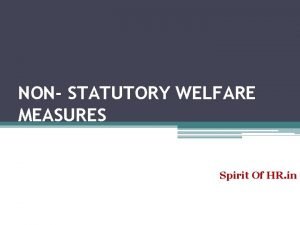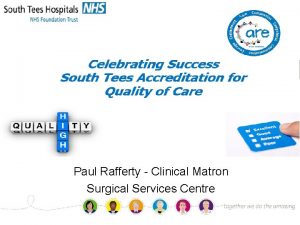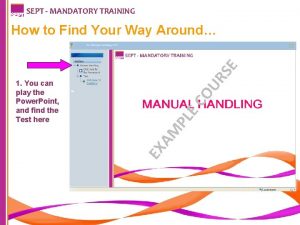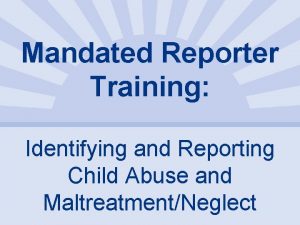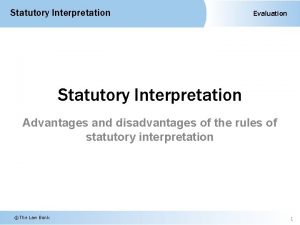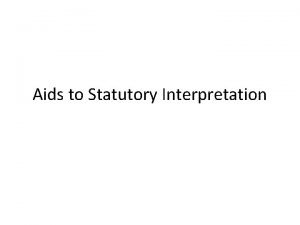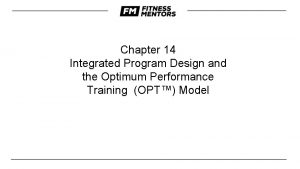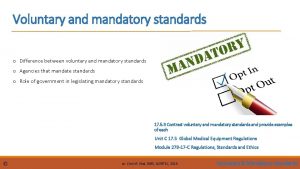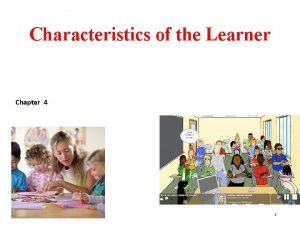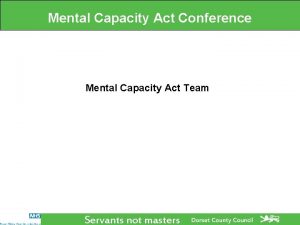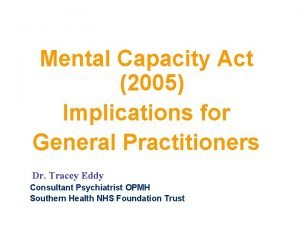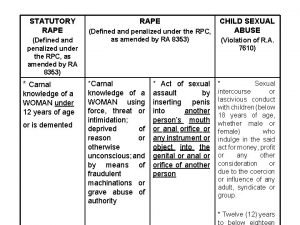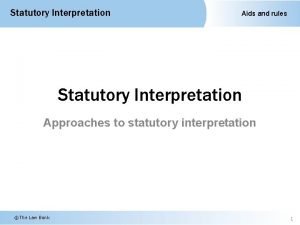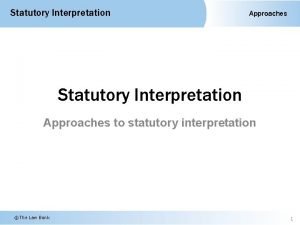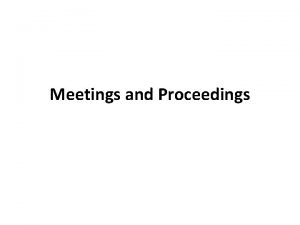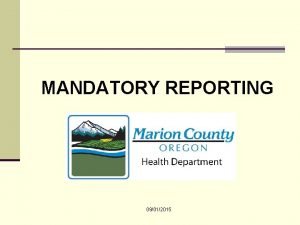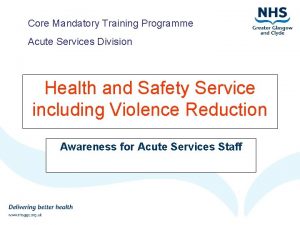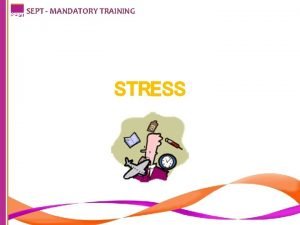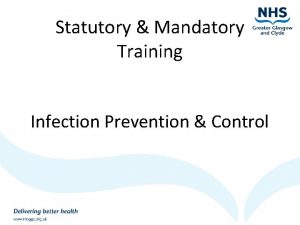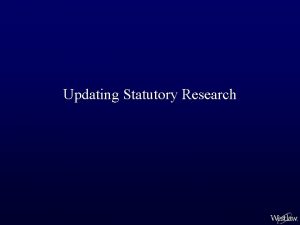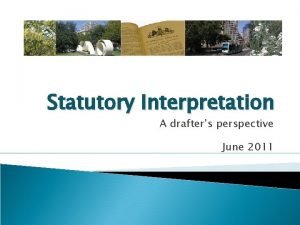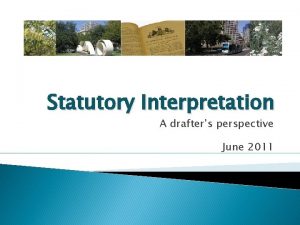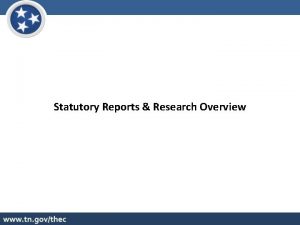Acute Statutory and Mandatory Core Training Programme Core




























- Slides: 28

Acute Statutory and Mandatory ‘Core Training Programme’ Core Mandatory Training Programme – Acute Services Division

Housekeeping Core Mandatory Training Programme – Acute Services Division

About the programme • Topics agreed by Acute Directors • Attendance at the Core programme is every 3 years • Learning from the programme will link to your PDP Core Mandatory Training Programme – Acute Services Division

What presenters will provide • Up-to-date information on all topics. • The opportunity to update and add to your existing knowledge, interact and ask questions during the sessions. • Additional information on a range of resources to supplement today's content. Core Mandatory Training Programme – Acute Services Division

What presenters need from you • Use this learning opportunity to its fullest, have fun and enjoy the day. • To ensure you have signed ‘in’ at the start of the day, and ‘out’ at the end of the day. • To be considerate of other peoples learning needs and question in constructive and positive ways during each of the sessions. Core Mandatory Training Programme – Acute Services Division

• • • Our Culture Our Leaders Our Patients Our People Our Resources Core Mandatory Training Programme – Acute Services Division

NHSGG&C Organisational Values The way we work together – “Our behaviours” • • • We will put patients first We will focus on outcomes We take responsibility We always try to do things better We work as one team We treat each other with respect Core Mandatory Training Programme – Acute Services Division

Staff Governance The Standard requires all NHS Boards to demonstrate that staff are: • well informed; • appropriately trained and developed; • involved in decisions; • treated fairly and consistently, with dignity and respect, in an environment where diversity is valued; • provided with a continuously improving and safe working environment, promoting the health and wellbeing of staff, patients and the wider community. Core Mandatory Training Programme – Acute Services Division

Staff Governance • Keep themselves up to date with developments relevant to their job within the organisation; • Commit to continuous personal and professional development; • Adhere to the standards set by their regulatory bodies; • Actively participate in discussions on issues that affect them either directly or via their trade union/professional organisation; • Treat all staff and patients with dignity and respect while valuing diversity; • Ensure that their actions maintain and promote the health, safety and wellbeing of all staff, patients and carers. Core Mandatory Training Programme – Acute Services Division

Core Mandatory Training Programme Equality & Diversity Awareness for Acute Services Staff

By the end of this session you will, • Have refreshed your knowledge and understanding of Equality and Diversity'. • Have had an overview of current equality and related legislation • Understand what is meant by discrimination and recognise some of the causes • Have considered how equality and diversity issues impact on you and the service you provide • Know where to access further information and support

Warm up Quiz

Defining Equality & Diversity • Equality is about a fairer society where everyone can participate and has the opportunity to fulfill their potential • Diversity is difference in its broadest sense. To see it we must recognize, value & respect differences It’s not about treating everyone the same but as an individual Fair for All – The Wider Challenge SEHD, 2004

The purpose of the Equality Act • Ensures protection from discrimination, harassment or victimisation (by law) • Brings together 116 pieces of legislation/40 years of equalities law into a single source

What is Discrimination? Discrimination is: • About treating people less favourably based on their gender, age, social class, sexual orientation, race, faith & belief or disability. Discrimination can occur when: • Everyone is treated in the same way even when they have different needs.

Equality Act (Scotland) 2010 The Act has introduced protected characteristics: • Disability • Gender (sex) • Gender reassignment • Marriage or Civil Partnership • Pregnancy or maternity • Race • Religion or belief • Sexual Orientation • Age • NHSGG&C also includes Social Class

What does the law protect against? Direct Discrimination, where a person is treated less favourably that others because they have a protected characteristic. For example, a service may require patients to be of a certain age to qualify for treatment. If there is no objective justification for this, the exclusion it places on patients could constitute direct discrimination Indirect Discrimination, where a rule, guideline or policy exists that may inadvertently discriminate against an individual. For example, an outpatient service has a rule that each appointment time will not exceed 15 mins. The rule could indirectly discriminate against people who require communication support and therefore longer consultation times

The Equality Act also covers • Discrimination by association • Discrimination by perception • Harassment • Victimisation

Time to get you thinking!

Group Exercise – What should have happened? Case 1 Case 2 Martin is a Deaf man whose first language is British Sign Language (BSL). A smoker, Martin decided to quit by using the support of a group, however Martin was told that he could not attend a smoking cessation group because there was no budget for an interpreter. Tina is a transgender woman. She visited an NHS Clinic and when called was referred to as Stephen Watson – her former name. Tina approached the desk and explained her name was Tina and should be referred to as Tina or Ms Watson. The receptionist stated that the clinic would continue to use the name on his records until he presented a new passport. The following case studies are based on real examples within NHSGGC

Case 3 Julie is a gay woman whose partner is terminally ill. During a hospital visit, Julie was asked not to show affection to her partner because it was making other patients feel uncomfortable. Case 4 Jelina’s is an Pakistani women who cannot speak English or read in any other language. Jelina was admitted to hospital for a stay of several weeks. During her stay, staff did not communicate with her and she was left completely isolated. Jelina’s family has to draw pictures for her to use to make simple requests

Patient Rights Act • The Patient Rights (Scotland) Act 2011 supports the Scottish Government’s vision for a high quality NHS that respects the rights of patients, their carers, and all the people who deliver NHS services. The Act aims to: • improve patients’ experiences of using health services • become more involved in their health and healthcare • acknowledges the important role of carers • encourages responsible use of NHS services and resources • recognises that NHS staff and all providers of NHS services should be treated with dignity and supported to do their jobs well

NHS Quality Strategy (2010) - Caring and compassionate staff and services - Clear communication and explanation about conditions and treatment - Effective collaboration between clinicians, patients and others - A clean and safe care environment - Continuity of care - Clinical excellence.

A Fairer NHS Greater Glasgow and Clyde What Does It Mean For Me?

A fairer NHS The creation of a fairer NHS, GGC has developed equality outcomes from 2013 We will continue to work towards: • Removing barriers to all services for people with protected characteristics • Reducing/eliminating discrimination • Increasing awareness of all staff of the needs of groups with protected characteristics • Promoting positive attitudes and interactions between staff and services users All helping to reduce ‘inequality’ and ‘health inequalities’

Keeping up to date – Policy & Guidance • Facing the Future Together ‘values’ • NHS Quality Strategy 2010 • Legislation (H&S legislation and Patients Rights Act ) • • HR Policy > Dignity @ Work > Transgender Policy > Gender based violence Professional Codes of Conduct • Accessible Information Portal • Faiths & Beliefs manual • Bereavement Hub • Equality and Diversity Management Guidance

e. Learning Training - Equality & Diversity Microsite

Your role – After today • Make sure you are up-to date with: • Role modelling and visible commitment to equality – Equality Issues & Legislation – HR Policy & Practice Making sure what you say and do and how you behave is positive, supportive and promotes equality and diversity • Assess risk of discrimination in your service Find out and get involved in equality impact assessment (EQIA) • If you think something is discriminatory report it to your line manager
 Statutory and non statutory welfare measures
Statutory and non statutory welfare measures Core mandatory part 3
Core mandatory part 3 Ward accreditation programme
Ward accreditation programme Mandatory training definition
Mandatory training definition Normal bruising areas on a child
Normal bruising areas on a child London and north eastern railway v berriman
London and north eastern railway v berriman Intrinsic aids
Intrinsic aids Acute responses to training definition
Acute responses to training definition Opt.model
Opt.model Voluntary and mandatory standards
Voluntary and mandatory standards Crow foot notation weak entity
Crow foot notation weak entity Knowledge readiness to learn
Knowledge readiness to learn Statutory interpretation practice questions
Statutory interpretation practice questions 5 principles of the mental capacity act
5 principles of the mental capacity act Statutory principles of the mca
Statutory principles of the mca National curriculum core subjects
National curriculum core subjects Statutory rape rpc
Statutory rape rpc Aids to statutory interpretation
Aids to statutory interpretation Statutory relationship
Statutory relationship Rse steps
Rse steps Sompc
Sompc Independent maori statutory board
Independent maori statutory board Veterinary statutory body
Veterinary statutory body Broad approach golden rule
Broad approach golden rule Aids to statutory interpretation
Aids to statutory interpretation Statutory bonus meaning
Statutory bonus meaning Substantive law example
Substantive law example Nbsfo
Nbsfo Meeting adjournment
Meeting adjournment
